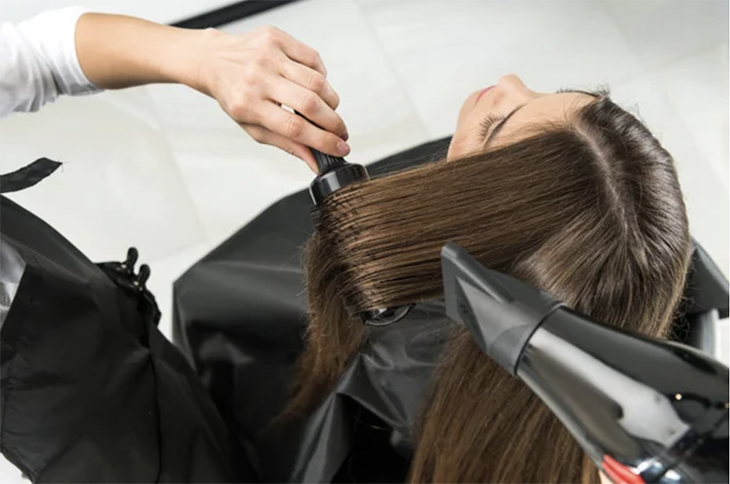
The U.S. Food and Drug Administration (FDA) has proposed a new rule aimed at banning hair-straightening products, commonly known as chemical relaxers, due to their association with health risks.
These risks include an increased likelihood of hormone-related cancers, such as breast cancer and uterine cancer. The anticipated rule would specifically prohibit hair-smoothening products containing formaldehyde (FA) and other FA-releasing chemicals like methylene glycol.
Should the proposed rule be issued, the FDA plans to seek public input through comments before making further decisions based on its review, following established guidelines.
How Formaldehyde is Released During Hair Straightening
The formaldehyde release in hair straightening occurs during the application of a smoothing solution, coupled with heat processing using flat-iron devices, resulting in the release of formaldehyde gas – a substance classified as a human carcinogen by the International Agency for Research on Cancer.
Uterine Cancer Risk Doubled for Women Using Hair Straightening Products
In October 2022, the Journal of the National Cancer Institute published findings from a study conducted by the National Institute of Environmental Health Sciences (NIEHS), shedding light on the heightened risk of specific cancers associated with frequent use of hair-straightening products. According to the research, women who used these products more than four times in the preceding year were over twice as likely to develop uterine cancer compared to non-users.
While the doubling of the risk is a cause for concern, the authors highlighted that uterine cancer remains relatively uncommon. The study revealed that an estimated 1.64 percent of women who had never utilized hair straighteners developed uterine cancer by the age of 70, in contrast to 4.05 percent among frequent users.
The investigation extended its scope to encompass various other hair treatments, including hair dye, bleach, highlights, and perms. Interestingly, no increased risk of cancer was observed in relation to these alternative hair care practices.
Formaldehyde, a well-established human carcinogen based on evidence from occupational and animal studies, has long been associated with these hair products. Dr. Alexandra White, the head of the NIEHS Environment and Cancer Epidemiology group in Research Triangle Park, North Carolina, and a coauthor of the study, emphasized the extensive body of evidence supporting formaldehyde’s carcinogenic properties.
Research conducted by the NIEHS, an integral part of the National Institutes of Health, plays a crucial role in shaping regulatory standards and policies aimed at safeguarding public health and safety. Dr. White affirmed that agencies like the FDA frequently rely on NIEHS findings to inform their regulatory decisions.
She further emphasized that scientists at the NIEHS remain committed to ongoing investigations into the potential health effects associated with the regular use of hair products, underlining a dedication to advancing our understanding of these critical health considerations. She explained, “Scientists at the NIEHS will continue to study potential health effects of regular use of hair products.”
The Risks of Straightening Products Have a Disproportionate Impact on Black Women
Back in March of 2023, Massachusetts congresswoman Ayanna Pressley and Ohio congresswoman Shontel Brown wrote a letter to request for an investigation by the FDA into the health risks involved when using hair straighteners.
Due to these products being predominantly marketed to and used by Black women, they wrote
“the increased risk disproportionally impacts Black women and contributes to national racial health disparities. The FDA has a mandate to review the latest research and reevaluate the safety of these products.”
In the NIEHS study, researchers discovered that approximately three out of every dive participants who frequently used straighteners identified themselves as Black women.
“Because Black women use hair-straightening or relaxer products more frequently and tend to initiate use at earlier ages than other races and ethnicities, these findings may be even more relevant for them,” said Che-Jung Chang, PhD, a coauthor of the study and a research fellow in the NIEHS Epidemiology Branch, in a press release.
Representative Brown said in a press release, “On behalf of women, especially Black women across the country, I applaud the FDA’s new proposed rule banning formaldehyde and other harmful chemicals from hair straighteners. We must ensure the products American consumers buy and use are safe, and I look forward to working with my colleagues and the administration to implement this proposed rule.”
Despite Being Rare, Uterine Cancer Still on the Rise in U.S.
Uterine cancer originates when cancerous cells develop in the endometrial tissues, constituting the lining of the uterus. Despite representing 3.4 percent of all newly diagnosed cancer cases, it stands out as the most prevalent cancer affecting the female reproductive system, and even estimated 66,200 new cases projected for the year 2023, as reported by the National Cancer Institute.
In contrast to the trends observed in many other types of cancer, uterine cancer rates are on the incline. Between 2010 and 2019, there has been an annual increase of 0.6 percent in newly reported cases. Additionally, the death rates associated with uterine cancer have shown an average annual rise of 1.7 percent during the same time frame.
These alarming statistics emphasize the growing impact of uterine cancer, warranting heightened attention and awareness within the realm of public health.
Increasing Incidence of Aggressive Uterine Cancer, Particularly Among Black Women
Between 2000 and 2015, there was a significant surge in the occurrence of aggressive subtypes of uterine cancer among women aged 30 to 79 in the United States, as indicated by a previous study sponsored by the National Institutes of Health (NIH). The study’s outcomes underscore notable racial disparities, manifesting in a heightened prevalence of these aggressive subtypes and a less favorable outcome for Black women, irrespective of cancer subtype and stage, in comparison to women from other racial and ethnic backgrounds.
Products Should Be Used with Caution, or Not At All, Until Proposal Is Made
The FDA also advises consumers to discuss products with salon professionals, inquire about formaldehyde content, and explore alternative products that do not release hazardous gases.
According to the Occupational Safety and Health Administration (OSHA), it is crucial to note that determining formaldehyde content in hair products can be challenging as even those claiming to be “formaldehyde-free” might contain synonymous ingredients, as seen by the lists below.
Products of concern might contain ingredients that are synonyms for formaldehyde or methylene glycol, such as:
- Formalin
- Methanal
- Methanediol
- Formaldehyde monohydrate
Chemicals that release formaldehyde when the product is heated, such as during flat-ironing or blow-drying, include:
- Timonacic acid
- Dimethoxymethane
- Decamethyl-cyclopentasiloxane



